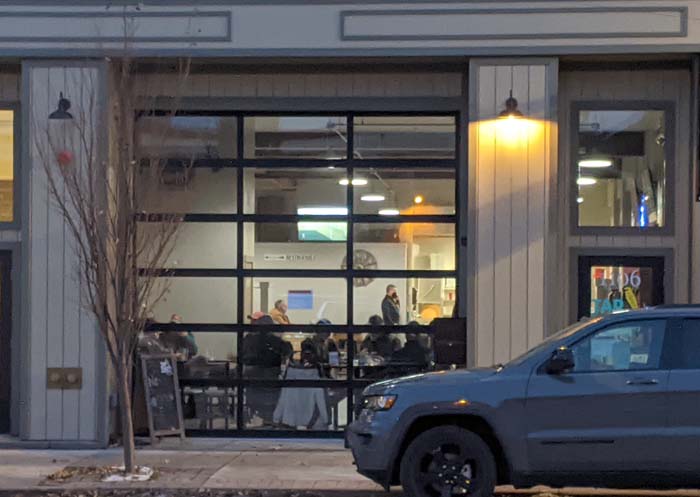Union County dropping to moderate risk
Published 5:00 am Thursday, February 25, 2021

- Tap That Growlers on Adams Avenue in downtown La Grande stays busy the evening of Nov. 12, 2020, six days before Gov. Kate Brown’s mandates went into effect that would lead to prohibitions against in-person dining at restaurants and bars throughout most of Oregon. Union County is dropping into the moderate risk category effective Friday, Feb. 26, 2021, meaning restaurants and other establishments can allow in-person business with restrictions.
UNION COUNTY — Friday, Feb. 26, Union County restaurants can open their doors to dine-in service once again.
Trending
Following a correction to a faulty COVID-19 report that mistakenly placed three cases in Union County, the Oregon Health Authority decreased the county’s risk level to “moderate.”
Kody Guentert, owner and operator of Brother Bear Cafe in downtown La Grande, said he’s jazzed for the drop.
“I’m excited,” he said. “I’ve been waiting a long time for it to happen — all the businesses I’ve talked to have.”
Trending
It is not only the financial stability that excites Guentert but the prospect of having customers and regulars return to the cafe for food, drinks and good times.
“There’s always going to be the fear with rules and regulations from Gov. Brown, and a lot of businesses are hurting,” he said. “Last thing they need is to have food not go out the door.”
Guentert said he understands why businesses might flout regulations regarding in-person dining: It’s a matter of survival.
Removing three COVID-19 cases from Union County’s record seems like a small thing, but it might make the difference for any number of local businesses..
Union County in a press release Tuesday, Feb. 23, explained county commissioners disputed a three-case discrepancy of COVID-19 the Oregon Health Authority incorrectly posted to the county’s totals. The county had totaled 46 cases for the period of Feb. 7-20, but after the fix, the total stands at 43 for the two-week period.
The three cases were in another county, according to the press release, and removing them dropped Union County two risk levels, from the extreme risk category to the moderate risk category, effective Friday, Feb. 26.
Union County is among the 10 counties out of Oregon’s 36 that Gov. Kate Brown Tuesday said were dropping off the extreme risk tier. Another six counties also will improve their infection risk levels.
The moves means restrictions on businesses, dining and activities will be less strict starting Friday for a long list of Oregon cities — including Astoria, Lincoln City, Prineville, The Dalles, Hermiston, Pendleton, La Grande and Ontario. Among the larger cities that will see less restrictions are Eugene, Salem, Medford, Beaverton, Albany, McMinnville and Oregon City.
Five counties — Jefferson (Madras), Benton (Corvallis), Josephine (Grants Pass), Douglas (Roseburg) and Coos (Coos Bay) — remain at the extreme risk level. That compares to 26 counties in late November at the height of the holiday spike in infections.
The state’s four-tier risk level rates counties at lower, moderate, high and extreme levels for COVID-19 spread. Ranking is determined by measures including total cases, cases per 100,000 people and positive infection rate. The higher the level, the more restrictive the rules on businesses and activities.
The state reevaluates levels every two weeks. Announcement of the next level changes will be March 9 and will go into effect March 12.
Frankie Chen, the owner of GC Asian Fusion, a few blocks down Adams from Brother Bear Cafe, said his staff is eager for Friday.
“All the employees are happy and excited, because in the past few months it’s been hard for everybody, and a lot of our staff are relying on their tips to survive,” he said.
He said during the ban on in-person dining, the restaurant only had to lay off one person — the dishwasher because there were no dishes. That was a critical position, he said, and will be again.
“I try to keep everyone working. That’s my priority,” Chen said. “Because, there’s a couple reasons for it. One is the disruption of the business. If you shut everything down, and try to open it back up, it’s pretty hard to do.
During the previous lockdown the restaurant lost about 25% of its staff, and he said many were living paycheck to paycheck and moved on to find other work.
“I have experience with that last time, so I refuse to lay anyone off,” he said. “So even if someone comes and they sit around, do some preparation or cleaning or whatnot, I simply have them come in just to hang out. I try my best to support everybody here. It’s good for me, and it’s good for them, too.”
The possibility of another shutdown remains a fear. He has another business in Baker City, he said, which went from extreme risk to high risk, but then a couple weeks later when COVID-19 cases jumped up, the restaurant had to shut down. But Chen said he is prepared for that and he gets why the state might close down businesses to protect communities.
“If it needs to shut down again, I’m all for it,” Chen said. “If the numbers jump, I’m all for it. I’m not against anybody. I’m not against our governor or anything like that. I see it from both sides.”
Sandy Sorrels, owner of La Grande’s Ten Depot Street, said moving to moderate restrictions will be good for those who can make it work for indoor dining at 50% capacity. But she said her business is taking a more cautious approach.
“It will make little difference for us at Ten Depot since we have decided to stick with our takeout business and develop outdoor seating for when the weather gets better,” she said. “The majority of our customers are not ready for indoor dining and neither is our staff. Until most people are vaccinated and our customers and staff are comfortable with being around groups of people again, opening for indoor dining is not feasible for us.”
— Gary Warner with the Oregon Capitol Bureau contributed to this article.
The State Sector Risk Level Guidance Chart from the Oregon Health Authority with all risk levels is available for viewing at sharedsystems.dhsoha.state.or.us/DHSForms/Served/le3461.pdf. Additional detailed state sector-specific guidance is at coronavirus.oregon.gov/Pages/guidance.aspx.
You can find information regarding COVID-19, including vaccinations, online at the Oregon Health Authority at govstatus.egov.com/OR-OHA-COVID-19, the U.S. Centers for Disease Control and Prevention at www.cdc.gov/coronavirus/2019-nCoV and the Center for Human Development’s Union County Public Health site at www.chdinc.org/covid19.









